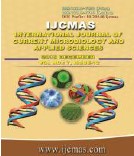


 National Academy of Agricultural Sciences (NAAS)
National Academy of Agricultural Sciences (NAAS)

|
PRINT ISSN : 2319-7692
Online ISSN : 2319-7706 Issues : 12 per year Publisher : Excellent Publishers Email : editorijcmas@gmail.com / submit@ijcmas.com Editor-in-chief: Dr.M.Prakash Index Copernicus ICV 2018: 95.39 NAAS RATING 2020: 5.38 |
Beneficial microbes can act as plant growth stimulants without affecting soil health thus in present study one of the beneficial photosynthetic microbe was used to study its effect on Anethum graveolens (Dill) plantlet. The Anabaena culture was used in defined concentration and its effect on germination rate, shoot length, root length, number of branches, pigments content, protein and nutrients quality of soil was carried out. Germination rate was found to be 40% more in seed treatment (ST) as compared to untreated (UT)/controlled Dill seeds. Shoot length was 10% higher in foliar spray treatment (FST) plants as compared to UT Dill plantlets. Numbers of branches were 13% more in FST treatment than UT. Similarly there was 2-6% increase in Chlorophyll a and Chlorophyll b pigments in FST and ST plantlets as compared to UT Dill plantlets. Also there was 14% increase in both organic carbon and nitrogen content of soil after FST treatment of Dill and 27% increase in both organic carbon and nitrogen content of soil after ST treatment of Dill. The results showed positive effect of seed and foliar spray treatment of cyanobacterial culture with respect to above mentioned parameters on Dill plantlets.
 |
 |
 |
 |
 |